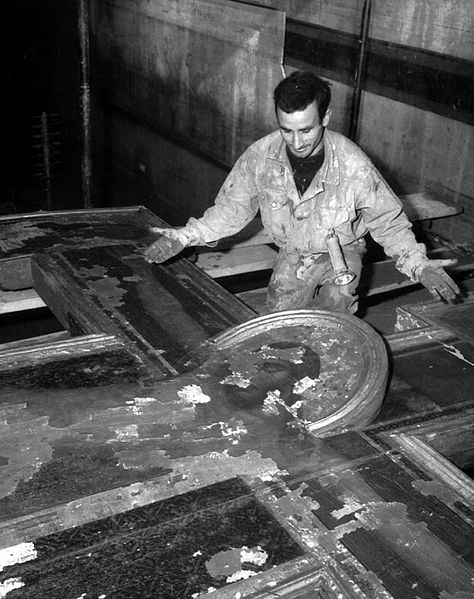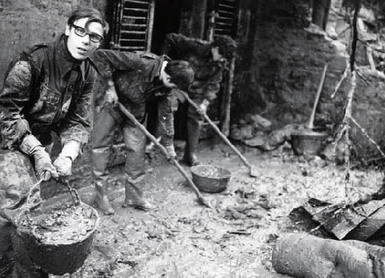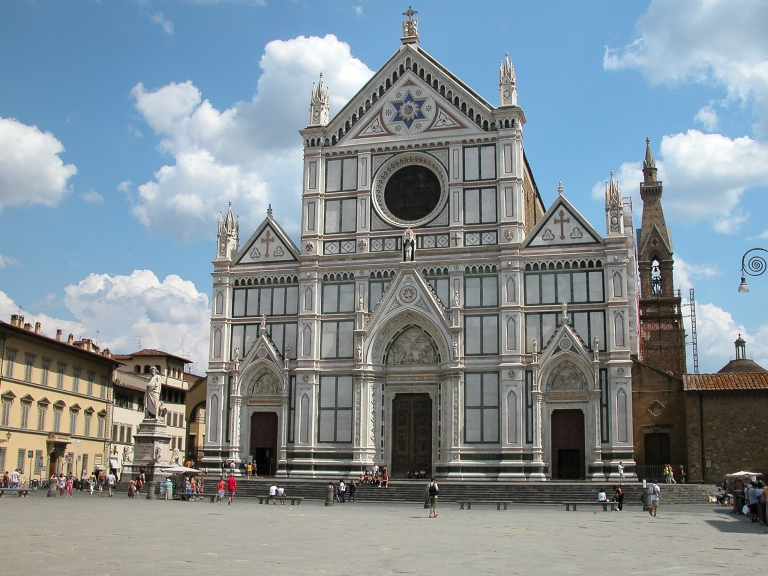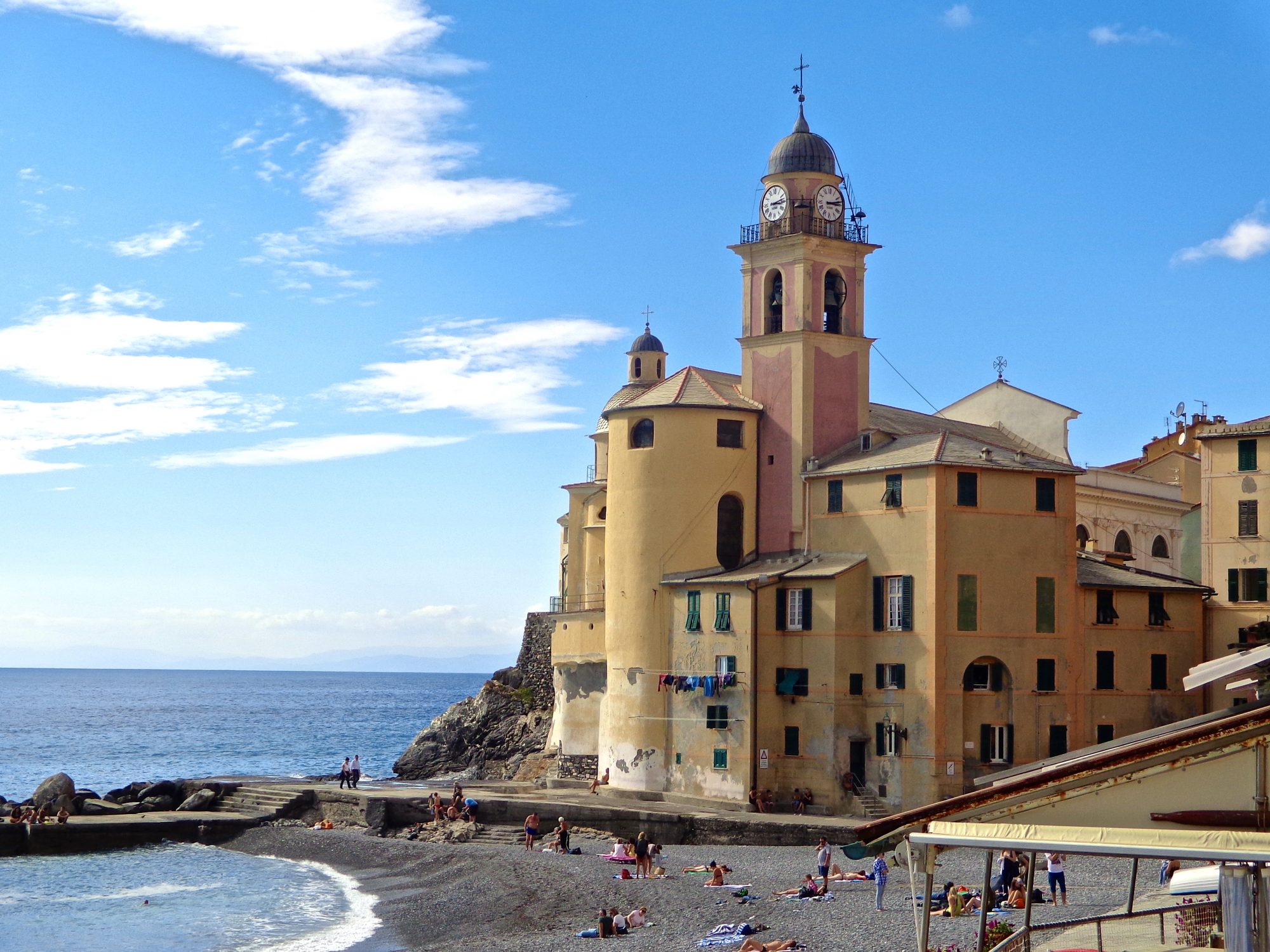He who works with his hands and his head and his heart is an artist.”
― St. Francis of Assisi

The flood of 1966 in Florence devastated millions of art masterpieces and rare books. The Franciscan Basilica of Santa Croce was one of many buildings left in terrible conditions. Swirling river bottom mud settled inside the church, causing heavy damage to valuable works of art. It took a long time and a lot of effort to remove all of the debris. Because of its geographical location, Florence often flooded, always leaving behind a muddy mess.
Volunteers from around the globe came to clean the city of refuse, mud, and oil. They removed works of art, books and other valuables from flooded rooms. Conservators worked tirelessly to restore these pieces to as close to their original condition as possible. These volunteers became known as Angeli del fango–angels of the mud.
On my first visit to the Basilica of Santa Croce, I passed Cimabue’s Crucifix, painted in 1272. It was heart wrenching to see the degree of water damage that had altered the painting. 60% of its paint was missing. Housed in the refectory of the Museo dell’Opera di Santa Croce, the flood waters had risen to twenty feet, taking most of the paint off of the over 700-year-old Christ figure.
The wooden crucifix absorbed so much water that it expanded by three inches and doubled its weight. It took years for the cross to shrink back down to its original size. I could see spots with sections missing. The wood had cracked, it grew mold, and paint began to flake off even after it was removed from the refectory. Later on, the cracks were filled in with prepared Poplar from the Casentino Forest, where Cimabue obtained the original Poplar. Little restoration which can be seen with the eye has been applied to the Crucifix, and it still bears the effects of water damage.




“What we were doing was dictated by the desire to give back the traces of the history of the past to future generations, so that it could be used for the spiritual growth of people who perhaps had yet to be born….it was the international community that worked to try to save Florence, this unique patrimony that belonged to the whole world.”
Mario Primicerio, Speciale Alluvione

As I continued my walk through the church, I felt a deep respect and appreciation for the many old works of art. They were all beautiful and rich with color, painted by famous art masters of the late medieval and early renaissance. I was touched by how an international community of caring people pitched in together to help in a time of crisis, to save a heritage that is precious to everyone. It can be said that Cimabue’s Crucifix is a part of us all.

Ciao Susan How did I miss this post? The flood damage was so devastating, and it was all from human error. What a shame. I rented an apartment on Borgo Allegri in Firenze for a month in 2004, and when I read Giorgio Vasari’s ‘Lives of the Artists’ he mentions Cimabue and a whole parade of merry well-wishers carrying one of his panels through the streets to Santa Maria Novella! The area he was from was from then on called Borgo Allegri. I always remember this fondly when I think of Cimabue! Ciao, Cristina
LikeLiked by 1 person
Hi Cristina! Thank you for sharing your experience on Borgo Allegrini. What a great one indeed!! It brings tears to my eyes reading about this flood devestation and looking at the photos. But I love to imagine the triumphal parade of Cimabue as they carried his panel through the streets. Wish I could have been there:) Buon Natale, my friend!!
LikeLiked by 1 person
Yes it was devastating. I had the opportunity to speak to Maria Luigia Guaita when I was at Il Bisonte in the Altrarno. She is the founder ( now deceased)and I saw the small window to her bedroom that her nephew pulled her out of to save her from the flood. They still had the water level marked. It was high! After I read your post it struck me that poor Cimabue’s name means Oxhead! Ha ha! I wonder why they got that name? Buon Natale!
LikeLiked by 1 person
Oh Cristina, I would love to read an article by you on this entire experience of yours. You have some interesting things to share that I know people would love to know. Consider it at least….Cimabue and Oxhead, ha!
LikeLiked by 1 person
Grazie Susan. It is on my list of things to write about. I just need to visit Firenze to interview her great-nephew. Will do it one of these days! Cristina
LikeLiked by 1 person
I love the St. Francis quote. I always learn something from your posts.
LikeLiked by 1 person
It’s amazing any of it was able to be restored after all that flooding, Susan. Goes to show what can be accomplished when the human spirit sets their mind to something. Thank you for sharing.
I wanted to introduce you (though you may already know) to a fellow blogger, Sherri Matthews who writes on her blog, “A View From My Summerhouse”. She just recently wrote a post on a trip to Italy looking for inspiration to write again and thought you might enjoy the read and photos. Maybe, you’ve been there, Limone? Her post is called, “An Italian Journey: Writing and Healing”, at https://sherrimatthewsblog.com/2016/11/29/an-italian-journey-writing-and-healing/.
It’s good to see you again and always enjoy what you share and put out in the world. Thank you, Susan. Love and hugs xxoo
LikeLiked by 1 person
Thank you Pat!! Buon Natale too…I did read Sherri’s post and loved it. So good to hear from you.
LikeLiked by 1 person
Ah, I like that, Susan (had to look up the definition of Buon Natale — haha). It’s good to hear from you, too and reconnect. I hope all is well. Love and hugs, my friend. 🙂
LikeLiked by 1 person
Susan, I’ve never given it much thought before about all the work that goes behind the restoration and preservation of historical buildings and art. Your post boasts what a labor of love is required to make history available for all of us to appreciate and enjoy. I won’t be taking artifacts and heritage buildings for granted anymore.
Blessings ~ Wendy
LikeLiked by 1 person
Thank you so much, Wendy! I have a special place in my heart for these historical works of art. Blessings to you:):0
LikeLiked by 1 person
Another great post. I always learn something new from you. Thanks. This is a great church and a testament to wonderful art.
LikeLiked by 1 person
Thank you, George:) It sure is a wonderful church full of gorgeous art…
LikeLike
This is one of my favorite churches in all of Italy. Not so much for its beauty, but because of its history. I had never seen those photos before. Everyone talks about the damage that the flood caused to the Uffizi, but you don’t often hear about Santa Croce’s damage. In fact, last time that I was there in 2010 they were restoring it (the altar, I think). Do you know if it’s done yet?
LikeLike
Hi Rick, thanks for the comment….I do know that all of the major frescoes of the high altar are said to be finished, and that the Crucifix by the Master of Figline has recently been completed and rehung. By now the scaffolding may be gone, but not sure. I’m going back in September so plan to definitely check it out. I got to thinking today about the huge responsibility the Italian government has to keep all of these amazing treasures kept in good condition….I read somewhere that the majority of funding for the entire altar project came from a wealthy Japanese man.
LikeLike
Yes, funding is a huge problem in Italy. Not only are the funds insufficient, but Italy blessed/cursed with SO MANY amazing treasures that the task becomes overwhelming and many important treasures (ex. Pompeii, the Colosseum) are crumbling. Private funding is the only hope, really, and thankfully foreign donations are becoming more common. Bravi!
I look forward to hearing more after you return from Florence. Ciao!
LikeLike